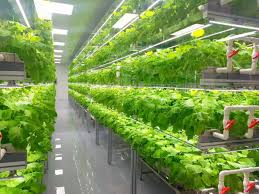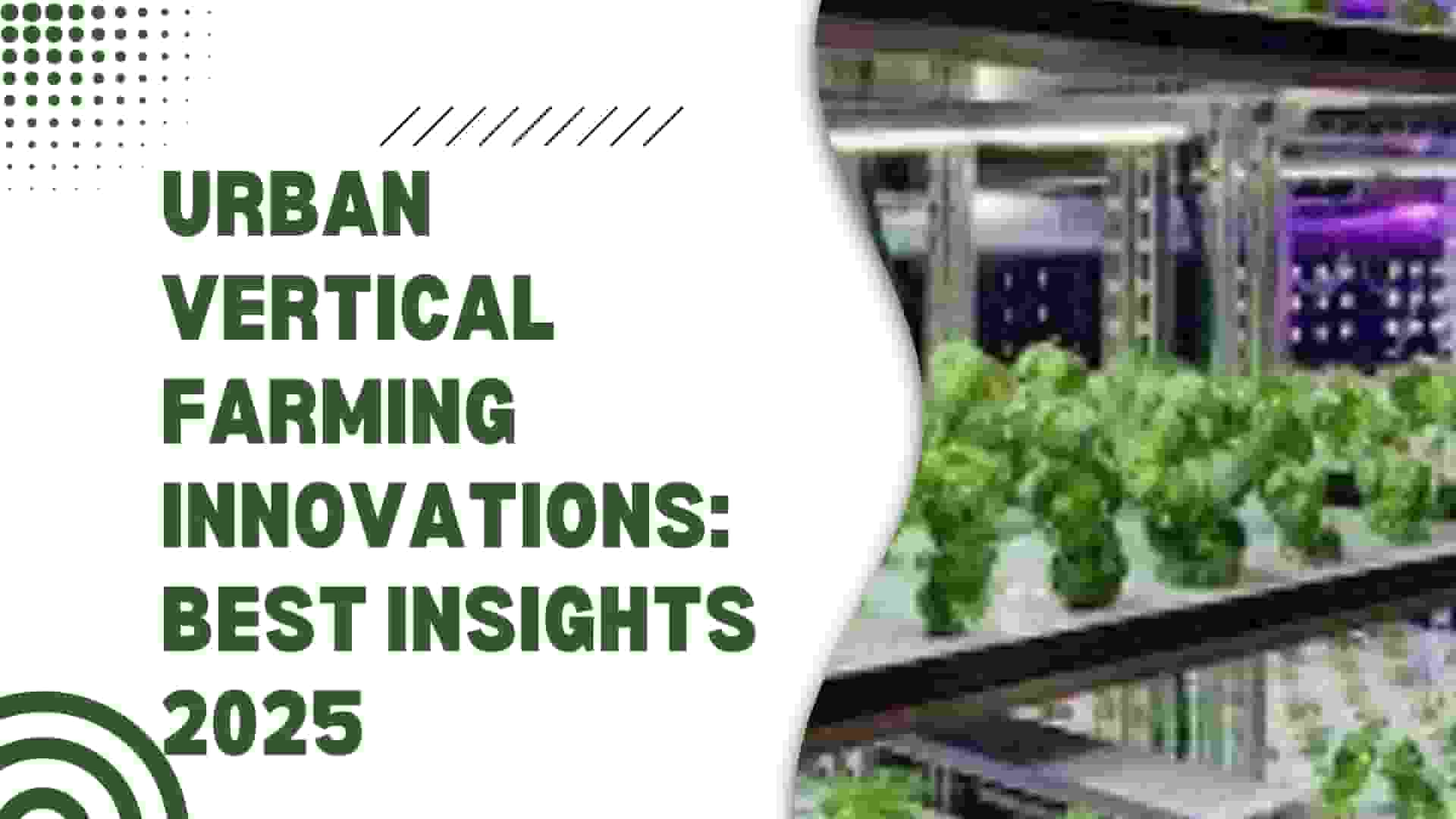-
Did you know that by 2050, nearly 80% of the world’s population will live in cities, munching on food that’s often trucked in from miles away? Picture this: a bustling city where skyscrapers don’t just house offices but grow fresh tomatoes, kale, and strawberries. Sounds like a sci-fi movie, right? Welcome to the world of vertical farming, where urban agriculture is reaching new heights—literally! In this blog post, we’ll dive into the latest urban vertical farming innovations that are transforming how we grow food in concrete jungles. From high-tech hydroponics to AI-driven farms, we’ll explore why this green revolution is a game-changer for all ages, with a sprinkle of humor to keep things fresh. Ready to grow up? Let’s dig in! What Is Vertical Farming?
Vertical farming is like stacking your garden into a high-rise building. Instead of sprawling fields, crops grow in layers, often indoors, using controlled environments. Think of it as a veggie skyscraper where plants thrive under LED lights, sipping nutrient-rich water without a speck of soil. This method maximizes space, making it perfect for urban areas where land is scarcer than a parking spot on Black Friday.
Imagine growing fresh strawberries or crisp lettuce in a city skyscraper, without a speck of soil or a sprawling field in sight. Sounds futuristic, right? That’s vertical farming—a game-changing way to grow food in stacked layers, often indoors, using cutting-edge technology. It’s like giving plants a high-rise apartment with all the amenities they need to thrive! In this guide, we’ll break down what vertical farming is, how it works, and why it’s revolutionizing urban agriculture. Let’s dive into the world of sky-high crops! Vertical farming is a method of growing crops in vertically stacked layers or structures, typically in controlled indoor environments like buildings, warehouses, or even shipping containers. Instead of spreading out across acres of land, crops are grown upward, maximizing space in tight urban settings. It uses advanced technologies to control light, water, and nutrients, ensuring plants grow efficiently year-round, no matter the weather outside.Think of it as a high-tech garden where plants live in a perfectly curated environment, sipping nutrient-rich water under artificial lights. It’s ideal for cities where land is scarce, and fresh produce is often trucked in from far away. Curious about urban agriculture? Check out our urban agriculture trends guide. Key Components of Vertical Farming
- Hydroponics: Plants grow in water-based solutions, no dirt needed.
- Aeroponics: Roots dangle in air, misted with nutrients.
- Controlled Environment Agriculture (CEA): Tech controls light, temperature, and humidity.
These systems allow farmers to grow food year-round, regardless of weather. It’s like giving plants a five-star hotel with perfect conditions! Curious about hydroponics? Check out our guide to hydroponics for more details.
Why Vertical Farming Matters
Cities are growing faster than a weed in spring, and feeding urban populations is a massive challenge. Traditional farming eats up land and water, and transporting produce racks up carbon emissions. Vertical farming swoops in like a superhero, offering sustainable solutions for urban food production. It’s not just about growing lettuce; it’s about rethinking how we feed the planet.
Urban Challenges It Solves
With 80% of people expected to live in urban areas by 2050, vertical farming addresses key issues:
- Land Scarcity: Uses vertical space, not sprawling acres.
- Food Miles: Grows food where it’s eaten, cutting transport emissions.
- Food Deserts: Brings fresh produce to areas with limited grocery access.
According to Eden Green, vertical farms can produce crops year-round, making seasonal shortages a thing of the past.

Innovations in Vertical Farming
The vertical farming industry is buzzing with tech that sounds like it’s straight out of a sci-fi novel. From robots to AI, here’s how innovation is pushing urban agriculture to new heights.
AI and Automation
Artificial intelligence is the brain behind modern vertical farms. AI monitors plant health, adjusts lighting, and optimizes water use. Imagine a farm where robots plant seeds and harvest crops while you sip coffee. Companies like Agritecture showcase farms using AI to boost efficiency.
LED Lighting Breakthroughs
LED lights mimic sunlight, but smarter. New dynamic LEDs, like those from Sollum Technologies, adjust wavelengths to suit specific crops, boosting yield and flavor. It’s like giving plants a personalized sun tan!
Electro-Ag Technology
Ever heard of plants growing in the dark? Electro-Ag tech uses electric fields to stimulate growth, slashing energy costs. This breakthrough could make vertical farming even more sustainable.
Benefits of Vertical Farming
Vertical farming isn’t just cool tech—it’s a win for the planet and your plate. Here’s why it’s a big deal.
Environmental Wins
Benefit Description Water Savings Uses 90% less water than traditional farming. Reduced Pesticides Controlled environments minimize pest issues. Lower Emissions Local production cuts food transport carbon footprint. Community Impact
Vertical farms create jobs, from tech specialists to urban farmers. They also bring fresh, nutrient-dense food to city dwellers, reducing reliance on imported produce. Plus, rooftop farms can turn gray cities green, improving air quality.
Want to see how urban farming boosts communities? Read our community gardening post.
Challenges in Vertical Farming
Vertical farming isn’t all sunshine and rainbows (or LED lights and mist). There are hurdles to clear before it becomes mainstream.
High Startup Costs
Setting up a vertical farm is pricier than a penthouse suite. Tech like AI, LEDs, and hydroponics systems requires big bucks upfront.
Energy Consumption
Those fancy LEDs and climate controls guzzle electricity. Innovations like Electro-Ag aim to cut energy use, but it’s still a challenge.
Public Awareness
Many folks don’t know vertical farming exists. Educating consumers and policymakers is key to scaling up, as noted in a FundsforNGOs proposal.
How to Start Your Own Vertical Farm
Ready to grow your own urban jungle? Here’s a beginner’s guide to starting a vertical farm, no green thumb required.
Steps to Get Growing
- Research: Study hydroponics and CEA basics.
- Choose a Space: Start small with a basement or rooftop.
- Invest in Tech: Get LEDs, nutrient systems, and sensors.
- Pick Crops: Leafy greens and herbs are beginner-friendly.
- Market Your Produce: Sell to local restaurants or markets.
Check out our beginner farming tips for more advice.
Dreaming of growing fresh lettuce or herbs in your urban apartment or a city rooftop? Vertical farming makes it possible to turn that dream into reality, even if your only “farm” experience is watering a houseplant! This guide will walk you through the steps to start your own vertical farm, from choosing the right space to harvesting your first crop. Whether you’re a city dweller or an aspiring urban farmer, we’ll keep it simple, practical, and a bit fun. Ready to stack your garden sky-high? Let’s get growing! Step 1: Learn the Basics of Vertical Farming
Before you dive in, get familiar with what vertical farming is all about. It’s growing crops in stacked layers, often indoors, using tech like hydroponics (water-based growing) or aeroponics (mist-based growing). You’ll control light, water, and nutrients to create a perfect plant paradise.
- Research: Read up on hydroponics, aeroponics, and controlled environment agriculture (CEA).
- Resources: Check out our hydroponics guide or visit Agritecture for tutorials.
Step 2: Pick the Perfect Space
You don’t need a sprawling field—just a corner of your home, a basement, or a rooftop. The key is maximizing vertical space. Here’s what to consider:
Space Type Pros Cons Indoor (e.g., apartment) Easy climate control, year-round growing Limited space, needs artificial lighting Rooftop Natural light, more space Weather exposure, zoning permits Warehouse Large-scale potential High setup costs Start small if you’re a beginner. A 4×4-foot area can produce enough greens for a family!
Step 3: Get the Right Equipment
Vertical farming relies on tech to mimic nature. Here’s what you’ll need:
- Grow Lights: LED lights tailored for plants (look for full-spectrum options).
- Hydroponic/Aeroponic System: Kits like those from Eden Green are beginner-friendly.
- Nutrient Solutions: Liquid fertilizers for hydroponics.
- Sensors: Monitor temperature, humidity, and pH levels.
- Shelving or Racks: Stackable trays to create vertical layers.
Budget tip: Start with a small DIY system for under $500. Check out our DIY farming kits guide for recommendations.
Step 4: Choose Beginner-Friendly Crops
Not all plants love the vertical life. Stick to crops that grow fast and don’t need much space:
- Leafy Greens: Lettuce, kale, spinach.
- Herbs: Basil, cilantro, mint.
- Microgreens: Tiny, nutrient-packed plants ready in weeks.
These crops thrive in vertical farming setups and are forgiving for newbies. Avoid heavy plants like pumpkins—they’re not ready for the high-rise life!

Step 5: Set Up and Monitor Your Farm
Once you’ve got your gear, it’s time to build your farm. Follow these steps:
- Install shelving or racks for vertical layers.
- Set up your hydroponic or aeroponic system per the manual.
- Plant seeds in grow trays with a medium like rockwool.
- Connect sensors to monitor light, water, and nutrients.
- Test the system for a week to ensure everything runs smoothly.
Pro tip: Use apps like FarmBot to track plant health remotely. It’s like babysitting your plants from your phone!
Step 6: Harvest and Sell Your Produce
Most greens are ready to harvest in 4–6 weeks. Snip, rinse, and enjoy—or sell! Here’s how to market your crops:
- Local Restaurants: Pitch fresh, hyper-local greens.
- Farmers’ Markets: Set up a stall for direct sales.
- Community Groups: Offer subscription boxes for neighbors.
Want marketing tips? Our urban farm marketing guide has you covered.
Conclusion
Urban vertical farming is more than a trend—it’s a revolution sprouting in cityscapes worldwide. By stacking crops sky-high, we’re tackling food security, cutting emissions, and bringing fresh produce to urban tables. From AI-driven farms to energy-saving LEDs, these innovations prove that the future of food is green and upward. Whether you’re a city dweller or a curious gardener, vertical farming offers a chance to grow smarter. So, why not join the movement? Leave your thoughts in the comments below or share how you’d bring vertical farming to your city!

FAQs About Vertical Farming
1. What crops can be grown in vertical farms?
Vertical farms excel at growing leafy greens like lettuce, kale, and spinach, as well as herbs, strawberries, and microgreens. These crops thrive in controlled environments, requiring less space and time than traditional farming.
2. Is vertical farming sustainable?
Yes! Vertical farming uses up to 90% less water and eliminates pesticides. Local production cuts transport emissions, though energy use for lighting remains a challenge. Innovations like Electro-Ag are improving sustainability.
3. How much does vertical farming cost?
Startup costs can range from $10,000 for small setups to millions for large-scale farms. Equipment like LEDs and hydroponics drives costs, but long-term savings on water and land balance it out.
4. Can vertical farming feed entire cities?
While vertical farming can’t replace traditional agriculture, it can significantly boost urban food production. It’s ideal for fresh produce, reducing reliance on imports and enhancing food security.
5. How does vertical farming use technology?
Vertical farming relies on AI, IoT sensors, and LEDs to monitor and optimize plant growth. Automation handles planting and harvesting, while hydroponics and aeroponics deliver nutrients efficiently.


В этом информативном тексте представлены захватывающие события и факты, которые заставят вас задуматься. Мы обращаем внимание на важные моменты, которые часто остаются незамеченными, и предлагаем новые перспективы на привычные вещи. Подготовьтесь к тому, чтобы быть поглощенным увлекательными рассказами!
Выяснить больше – https://vyvod-iz-zapoya-1.ru/